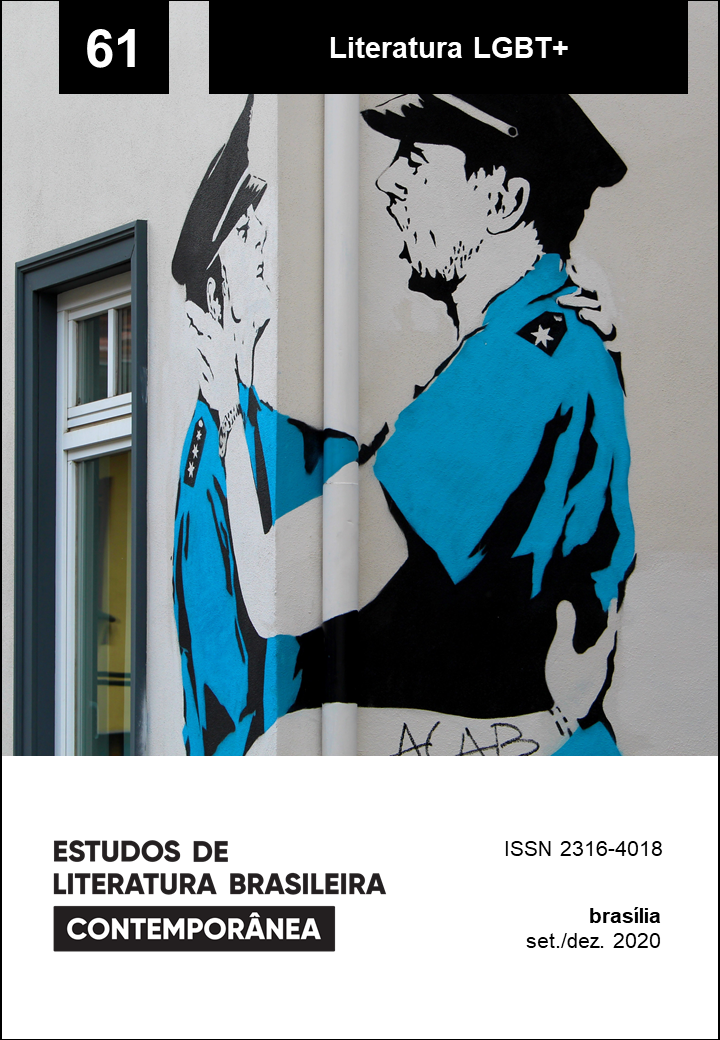Representations of the Lesbian Poetic Subject
DOI:
https://doi.org/10.1590/2316-4018613Keywords:
lesbian, representations, poetic subjectAbstract
Writing about “Compulsory Heterosexuality and Lesbian Existence”, the radical feminist and lesbian activist Adrienne Rich call attention to the double subjectivity of the lesbian woman’s political body. As a woman she is seen as a minor figure in a patriarchal and misogynistic society, and as a lesbian in a society that is additionally lesbophobic and fetishist. Years later, the lesbian poet Angélica Freitas asks us: “What is the use of a womb when it isn’t to make kids?”. Accordingly, the poet Simone Brantes, from Rio de Janeiro, gives voice to a lyrical self who asks: “how do two vulvas fit under the bedspread?”. The same thought of a capitalist society that sees women’s womb as an industry at her service is the same one that delegitimizes, fetishes, oppresses and try to erase affection, love, history and memory of a relationship between two women. This work aims to point out how love between lesbians is also political resistance, and how the lesbian poetic subject ”“ of lesbian authorship ”“ is important to this movement. For this, works of the aforementioned authors, Angélica Freitas and Simone Brantes, will be analyzed to reflect on gender, sexuality, subjectivities of the lesbian subject, and contribute to the discussion about these subjects that often pass through many processes of erasure.
Downloads
References
ANZALDÚA, Gloria (2009). To(o) queer the writer ”“ loca, escritora, y chicana. In: KEATING, AnaLouise (Ed.). The Gloria Anzaldúa reader. Durham: Duke University Press. p. 163-175.
BRANTES, Simone (2016). Quase todas as noites. Rio de Janeiro: 7Letras.
BUTLER, Judith (2003). Problemas de gênero: feminismo e subversão da identidade. Rio de Janeiro: Civilização Brasileira.
DALCASTAGNÈ, Regina (2012). Literatura brasileira contemporânea: um território contestado. Vinhedo: Horizonte.
FEDERICI, Silvia (2017). Calibã e a bruxa: mulheres, corpo e acumulação primitiva. Tradução DE coletivo Sycorax. São Paulo: Elefante.
FREITAS, Angelica (2017). Um útero é do tamanho de um punho. São Paulo: Cia das Letras.
FUNCK, Susana Bornéo (2011). O que é uma mulher. Revista Cerrados, Brasília, v. 20, n. 31, p. 64-74.
IORIO, Maria Isabel (20196). Aos outros só atiro o meu corpo. Bragança Paulista, SP: Urutau.
LANDOWSKI, Erick (2002). Presenças do outro: ensaios sobre sociossemiótica. São Paulo: Perspectiva.
MISKOLCI, Richard (2014). Teoria queer: um aprendizado pela diferença. Belo Horizonte: Autêntica.
PELÚCIO, Larissa (2012). Subalterno quem, cara pálida? Apontamentos à s margens sobre pós-colonialismos, feminismos e estudos queer. Contemporânea, v. 2, n. 2, Dossiê Saberes Subalternos, p. 395-418, jul./dez.
PRECIADO, Paul B. (2014). Manifesto contrassexual: práticas subversivas de identidade sexual. São Paulo: n-1 edições.
RICH, Adrienne. Heterossexualidade compulsória e existência lésbica & outros ensaios. Rio de Janeiro: A Bolha, 2019.
SALIH, Sara (2015). Judith Butler e a teoria queer. Belo Horizonte: Autêntica.
SILVA, Antonio de Pádua Dias da (2016). Literatura de língua portuguesa e homoafetividade: o aspecto político na ficção contemporânea. In: CAMARGO, Fábio Figueiredo; GARCIA, Paulo César (Org.). Homocultura e linguagens. Salvador: Eduneb.
Downloads
Published
How to Cite
Issue
Section
License
Copyright (c) 2020 Ágnes Christiane de Souza

This work is licensed under a Creative Commons Attribution-NoDerivatives 4.0 International License.
Authors who publish in this journal agree to the following terms:
a) The authors maintain the copyright and grant the journal the right of first publication, the work being simultaneously licensed under the Creative Commons Attribution License-Non Commercial 4.0 which allows the sharing of the work with acknowledgment of the authorship of the work and publication this journal.
b) Authors are authorized to enter into additional contracts separately, for non-exclusive distribution of the version of the work published in this journal (eg publish in institutional repository or as a book chapter), with authorship recognition and publication in this journal.
c) Authors are allowed and encouraged to publish and distribute their work online (eg in institutional repositories or on their personal page) after the editorial process, as this can generate productive changes, as well as increase the impact and citation of published work (See The Effect of Free Access).
d) The authors of the approved works authorize the magazine to, after publication, transfer its content for reproduction in content crawlers, virtual libraries and the like.
e) The authors assume that the texts submitted to the publication are of their original creation, being fully responsible for their content in the event of possible opposition by third parties.


